Viajando en el tiempo 1┬║ba
Download as pptx, pdf0 likes2,485 views
People lived during the Neolithic period from 7000 BC to 3500 BC. This was a time when early humans began developing new skills and trades as craftsmen. The Neolithic period marked the beginnings of these craft-based occupations.
1 of 26
Download to read offline
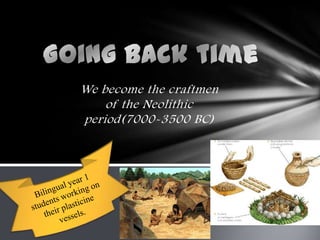
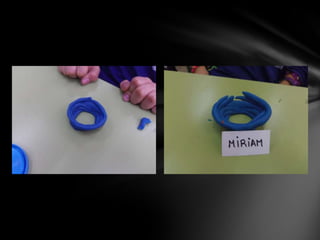
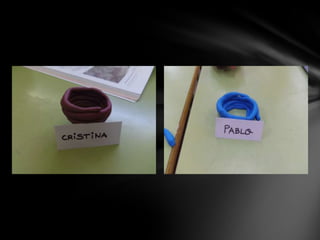

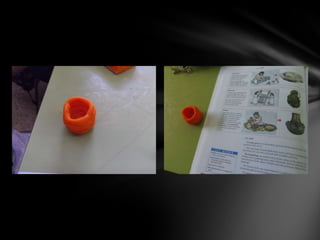


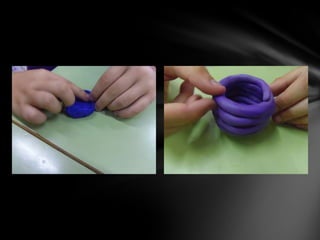
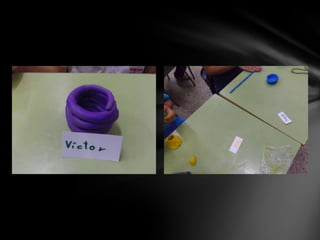
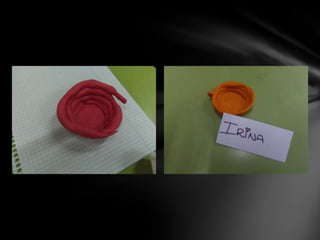
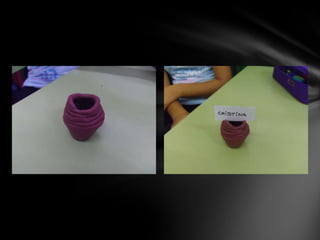

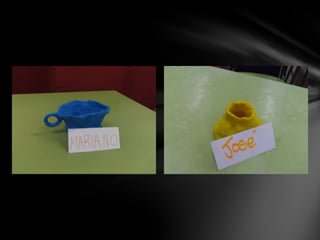
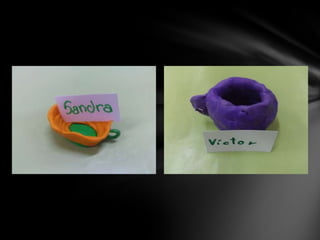

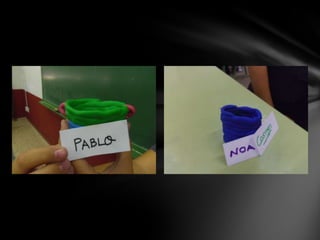

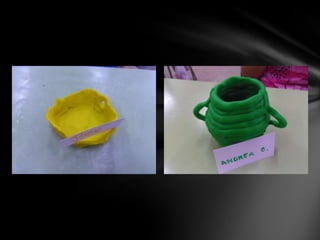
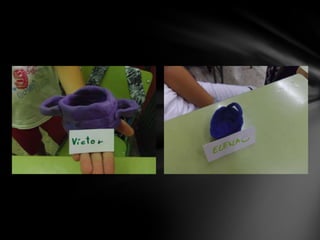



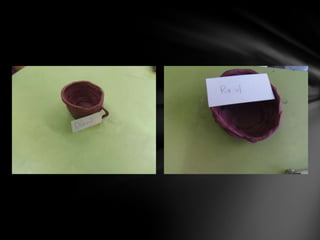
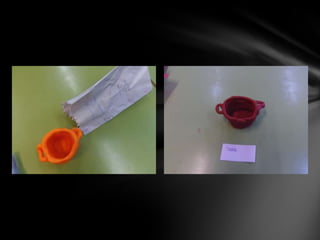
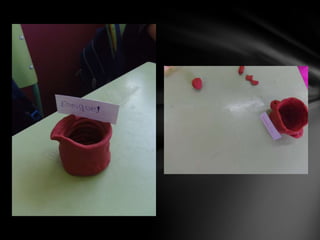

Recommended
Examen ancient rome
Examen ancient romealmusociales
╠²
This document contains questions from a social studies exam on Ancient Rome. It asks the student to:
1) Create a timeline of significant events from early human history to modern times, including a more detailed timeline of the three historical periods of Ancient Rome.
2) Define vocabulary terms from Ancient Rome and provide Spanish translations.
3) Answer multiple choice and short answer questions about the founding of Rome, the Roman Republic, gods and goddesses, and identify buildings and columns on maps and diagrams.
The document contains review questions to test the student's knowledge of the history and culture of Ancient Rome from early humans through the Roman Empire. It focuses on key events, political structures, mythology, and architectural stylesExam Ancient Rome
Exam Ancient Romealmusociales
╠²
This document contains questions for a social studies exam on ancient history. It asks the student to:
1) Create a timeline of major periods in human history and significant events.
2) Create a more detailed timeline of the three periods of Ancient Greece and their important wars.
3) Define key terms from ancient Greece in both the original language and Spanish translation.
4) Match hominid groups to characteristics like tool use and cave paintings. Describe religions in the Metal Age. Identify Alexander the Great. Discuss early writing.
5) Explain Greek colonies on a map and their economic activities. Draw Egypt's social pyramid. Identify citizens and non-citizens in Greece.Mountain environments
Mountain environmentsalmusociales
╠²
The mountain environment is found above 2000 meters in elevation and supports unique flora and fauna, including mosses, lichens, birds of prey, and goats. Key economic activities in mountain environments include farming and tourism.Unit 0 the roman empire and its decline
Unit 0 the roman empire and its declinealmusociales
╠²
Augustus becomes the first Roman emperor in 27 BC, bringing stability after a period of civil war. The Roman Empire reaches its peak under Emperor Trajan. However, in the 3rd century, civil wars break out as generals vie for power, and Germanic tribes attack Roman towns. This instability is resolved under Emperors Diocletian and Constantine. Eventually, Germanic invasions and the division of the empire lead to the fall of the Western Roman Empire in 476 AD, while the Eastern Empire survives as the Byzantine Empire for another 1,000 years. Kingdoms established by the Franks, Visigoths, and Ostrogoths replace the government of the Western Empire.Examen seg trimestre 3┬║a economic activity
Examen seg trimestre 3┬║a economic activityalmusociales
╠²
This document contains vocabulary terms and questions about economic concepts for a social studies exam. It asks the student to define 10 vocabulary terms by providing the Spanish translation. It also contains 5 questions requiring explanations and examples of factors of production, economic systems, economic agents, and a summary of changes in the labor market covering topics like unemployment, technology, workers, companies, working conditions, and gender inequalities. The student is instructed to show the question number and spelling will be graded.Periods in the history of al andalus and its
Periods in the history of al andalus and itsalmusociales
╠²
The document outlines the major periods in the history of al-Andalus and its art from the 8th century to the late 15th century. It begins with the Dependent Emirate period where al-Andalus was governed by an emir under the Caliph of Damascus. It then discusses the Independent Emirate period after Abd-al-Rahman I established himself as emir. Next, it covers the C├│rdoba Caliphate period when Abd-al-Rahman III proclaimed himself Caliph. Following this was the era of the Taifa Kingdoms and North African dynasties, before the last Taifa and Nasrid Kingdom of Granada until its fall in 1492. ForHistory of spain 19th century project_christamas
History of spain 19th century project_christamasalmusociales
╠²
Carlos IV became King of Spain in the late 18th century. During his reign, Napoleon occupied Spain and forced Carlos IV and his son Fernando VII to abdicate in Bayonne in 1808. Napoleon then installed his brother Joseph Bonaparte as the new King of Spain. This led to the Spanish War of Independence as the Spanish people rebelled against French rule. The Central Council was formed in Cadiz in 1810 to coordinate the resistance and eventually established the Constitution of 1812, one of the most progressive in Europe at the time, establishing principles of popular sovereignty, separation of powers, and equal rights.Exceptional writing
Exceptional writingalmusociales
╠²
The document provides guidance on writing position papers, including brainstorming, developing a thesis, organizing ideas, taking notes, writing the body, and concluding. It emphasizes that brainstorming is important to see what is known and needs to be learned about the topic. The thesis should be significant and guide the essay. When organizing ideas, an outline with the introduction, main points, and conclusion can help. Quotations in notes and essays should be properly introduced and attributed. The body paragraphs should each have a topic sentence connecting to the thesis and supporting details. Conclusions should not just repeat the thesis but reference elements from the essay to make a lasting impression. An example position paper on globalization is provided and analyzed to demonstrate theseUnit 3 the ancien regime in crisis
Unit 3 the ancien regime in crisisalmusociales
╠²
The document provides an overview of the 18th century Enlightenment period in Europe and Spain. Some key ideas spread during this time included reason, science, education, equality, and liberty. Enlightenment thinkers criticized traditions and proposed political and economic reforms, though their ideas faced resistance. Examples of reforms included constitutional monarchy, separation of powers, and increased rights. Enlightened despotism developed but ultimately failed due to its retention of privileges. The American Revolution successfully established a federal republic based on Enlightenment principles of popular sovereignty and separation of powers. Spain underwent reforms under the new Bourbon dynasty including centralization of power and modernization of agriculture and craftsmanship.The political organisation of the world
The political organisation of the worldalmusociales
╠²
Geopolitics examines how societies are organized in relation to geographic space. The basic unit of organization is the state, which has sovereignty over its economy, politics, and culture. Currently, states cede some sovereignty to supranational organizations like the EU and UN for reasons of unity, free market access, and cooperation. The world contains over 200 states with complex political and economic relationships. Powerful countries like the US dominate politically, while wealthy nations like those in the EU and North America form the economic center. Developing and least developed countries have different economic roles within the global system.Tertiary sector
Tertiary sectoralmusociales
╠²
The tertiary sector includes economic activities that provide services rather than produce material goods, such as commerce, transportation, and leisure activities like tourism. Until the 20th century, tourism was limited to the wealthy, but it is now a major industry in developed countries. The tertiary sector accounts for a large share of GDP and employment in developed nations, where access to services is widespread, while in developing countries services are less developed and important.The weimar republic
The weimar republicalmusociales
╠²
The Weimar Republic was established in Germany after World War 1 and faced significant challenges, including economic devastation from war reparations imposed by the Treaty of Versailles. The early years of the Weimar Republic saw political instability from communist and nationalist groups as well as hyperinflation resulting from France occupying the Ruhr Valley. Under the leadership of Stresemann in the later years, Germany's economy and international standing improved through agreements like the Dawes Plan and Locarno Treaties, though unemployment and poverty remained problems.Spanish civil war
Spanish civil waralmusociales
╠²
The Spanish Civil War began in 1936 as a result of a military coup launched by Nationalist forces led by Francisco Franco against the Republican government. The war divided Spain into two zones - the Nationalist region controlled by Franco and the Republicans. The conflict lasted almost three years and involved three phases - the campaign for Madrid, the northern front, and the end of the war. Life during the war was difficult, with hunger, repression, and refugees fleeing the violence and exiles leaving Spain.Projections year2
Projections year2almusociales
╠²
Maps represent the spherical Earth on a flat surface, which requires projections that distort the globe's shape. Projections display the globe using planar, cylindrical, or conic shapes to flatten it. Scale relates distances on a map to actual distances, shown numerically as a ratio or linearly with a divided line. Numerical scale gives the fraction comparing map units to land units, while linear scale directly measures map distances.Types of maps year2
Types of maps year2almusociales
╠²
The document discusses different types of maps. It defines maps as pictures of Earth's surface that can be general reference maps showing landmarks and boundaries or thematic maps focusing on specific topics. Thematic maps grew in importance with GIS. The document describes political maps as showing only state and national boundaries and city locations, and physical maps as depicting landscape features like mountains, rivers, and elevation changes using colors. Thematic maps focus on a particular theme rather than just showing natural features, and were not widely used until the 17th century when base maps became accurate enough.Contemporary societies project
Contemporary societies projectalmusociales
╠²
This document provides instructions for a school project on contemporary societies. Students are asked to select a continent, then a region within that continent, and then a country within that region to research. They should provide general facts about the selected country and analyze a city within that country, describing its geographical environment, urban planning structure, urban problems, and proposing improvements.Population
Populationalmusociales
╠²
This document discusses key concepts related to population studies including:
1. It defines population and demography, and describes sources used to obtain population information like censuses and municipal registers.
2. It explains factors that influence population distribution including physical conditions, human conditions, and population density which is used to measure distribution.
3. It describes natural population change through births and deaths, and how birth rates and death rates are calculated and vary between developed and developing countries. Natural increase is the difference between births and deaths.
4. It discusses regular and migratory population movement, with migratory movement including emigration and immigration between places.Unit 7 the spanish empire
Unit 7 the spanish empirealmusociales
╠²
The document provides an overview of the Spanish Empire during the 16th century, which was marked by the reign of the Habsburg monarchs Carlos I and Felipe II. It discusses their domestic and foreign policies, including Carlos I inheriting kingdoms across Europe and fighting wars against France and the Ottoman Empire, and Felipe II establishing Madrid as the capital and fighting conflicts in the Netherlands and against England. It also summarizes the conquest of the Aztec and Inca Empires in the Americas in the 1520s and 1530s, and the consequences of the discovery, such as Spain and Portugal becoming colonial empires and the introduction of new crops and livestock to Europe and America.Unit 8 the first world war and the russian revolution
Unit 8 the first world war and the russian revolutionalmusociales
╠²
The document summarizes key events in Russia between 1871-1914 and during the Russian Revolution of 1917. It describes how Russia was an absolute monarchy in the late 19th century with a semi-feudal economy. Involvement in World War 1 exacerbated Russia's political and economic problems and led to two revolutions in 1917 - the February Revolution replaced the Tsar with a provisional government, while the October Revolution brought the Bolsheviks to power under Lenin. After a civil war, the Bolsheviks established the Soviet Union, implementing the first communist state based on a single-party dictatorship of the proletariat.2 ww
2 wwalmusociales
╠²
The document provides a summary of key events during World War II:
1) Germany invaded Poland on September 1, 1939, quickly defeating Poland through the use of Blitzkrieg tactics. Germany then invaded Denmark and Norway in April 1940 and used Blitzkrieg tactics to invade France in May 1940 through Belgium, bypassing the Maginot Line.
2) Britain survived Germany's planned invasion in 1940 thanks to the Royal Air Force prevailing over the Luftwaffe in the Battle of Britain during July-September 1940.
3) Britain depended on imports for resources but survived the German U-boat threat in the Battle of the Atlantic through 1942 by adopting convoy systems protected by radar-equipped shipsAn overview of geography year2
An overview of geography year2almusociales
╠²
Geography is the oldest of the sciences, studying the Earth and its features as well as human cultures. The word geography comes from the Greek words "geo" meaning Earth and "graphy" meaning writing. Today geography is divided into physical geography, which examines the natural world, and cultural geography, which studies human impacts and culture. Geographers study these areas and provide information to governments on topics like geology, urban planning, ecosystems, economics and more, making their work important.Lesson plan resources vocabulary and images_the3economic sectors
Lesson plan resources vocabulary and images_the3economic sectorsalmusociales
╠²
Eko Stahl Ag is a steel company located in Germany. The document discusses three images that represent different economic sectors: cultural tourism in the tertiary sector shown through a tour guide explaining an old church to visitors; the construction industry's impact on the environment seen through the transformation of an undeveloped landscape into buildings and infrastructure; and agriculture in the primary sector depicted by farmers collecting rice in Southeast Asia using manual techniques.Atlas of history activities from 1815 to 1945almusociales
╠²
El documento presenta una lista de 10 entradas numeradas que parecen referirse a pa├Łses importantes en Europa y en el mundo en diferentes per├Łodos de tiempo, aunque no se proporciona el nombre de los pa├Łses ni las fechas espec├Łficas. Cada entrada incluye el texto "LEYENDA Nombre de los pa├Łses m├Īs importantes y justificaci├│n de la cronolog├Ła aproximada".Altlas of history activities indexalmusociales
╠²
El documento presenta un ├Łndice de 16 evaluaciones relacionadas con mapas hist├│ricos de Europa y el mundo desde 1815 hasta 1993. La primera evaluaci├│n incluye diferentes tipos de mapamundis f├Łsicos y pol├Łticos. La segunda evaluaci├│n cubre los mapas de Europa en 1815, 1871, 1914 y 1919, as├Ł como el imperialismo y 1945. La tercera evaluaci├│n analiza la Guerra Fr├Ła, incluidas las superpotencias y pa├Łses sat├®lites, la Guerra Fr├Ła en Europa, la disoluci├│n de la Uni├│n Sovi├®tica y los cambios en los Balcanes y laUnits 6 and 7 review game
Units 6 and 7 review gamealmusociales
╠²
This document contains a review game with 17 questions about major historical events and concepts from the 19th century, including the Congress of Vienna, revolutions in France and Greece, Italian unification led by the Kingdom of Sardinia, German unification promoted by Prussia, the establishment of nation-states and today's world order between 1870-1914, consequences of capitalism, industrial powers like Britain and the US, the Meiji Revolution in Japan, the largest late 19th/early 20th century empire, British imperialism, and causes and consequences of imperialism. The review covers political, economic and social history from this time period.Unit 7 Capitalism and Imperialism
Unit 7 Capitalism and Imperialismalmusociales
╠²
Between 1870-1914, the foundations of the modern world were established. Major powers like Germany, the United States, and Japan industrialized rapidly. European nations colonized regions with raw materials to fuel their industries and markets for manufactured goods. This led to the rise of large colonial empires like the British and French empires. Imperialism created economic imbalances and exploited less developed nations, imposing European culture on colonies. Racial segregation and unequal treatment of native peoples were common in colonies. The rivalry between colonial powers also contributed to the outbreak of World War I.Unit 8 Reformation, Humanism, Renaissance Art
Unit 8 Reformation, Humanism, Renaissance Artalmusociales
╠²
This document provides an overview of humanism, the Protestant Reformation, the Counter-Reformation, and Renaissance art. It discusses key figures like Martin Luther who initiated the Protestant Reformation by rejecting the Pope's authority. It also describes the Counter-Reformation led by the Catholic Church in response to Protestantism through the Council of Trent. Additionally, it characterizes humanism as an intellectual movement that placed human beings at the center. Finally, it outlines the characteristics and major artists of the Renaissance in Italy, including figures like Brunelleschi, Ghiberti, Botticelli, Michelangelo, Raphael, and Leonardo da Vinci.Lesson plan routes of the spanish armada
Lesson plan routes of the spanish armadaalmusociales
╠²
Here are the Spanish translations for the vocabulary words from Queen Elizabeth's speech:
To take heed: tener cuidado
For fear of treachery: por miedo a la traici├│n
To distrust: desconfiar
To command: mandar
In the midstand heat of the battle: en medio y calor de la batalla
To be rewarded: ser recompensadoUnit 6 nationalism and liberalism
Unit 6 nationalism and liberalismalmusociales
╠²
1. The document summarizes the rise of nationalism and liberalism in Europe following the Congress of Vienna in 1815. It discusses the restoration of absolutism by the monarchies and their attempts to suppress nationalist and liberal ideas. However, revolutionary movements in the 1820s started to undermine this system.
2. The Revolutions of 1830 saw the bourgeoisie seize power in parts of Europe, establishing constitutional monarchies, such as in France. The Revolutions of 1848 called for further democratic reforms including universal suffrage and sovereignty of the people.
3. Nationalist movements in the 19th century led to the independence of Greece from the Ottoman Empire and Belgium from the Netherlands. The Spanish colonies in America alsoMore Related Content
Viewers also liked (11)
Exceptional writing
Exceptional writingalmusociales
╠²
The document provides guidance on writing position papers, including brainstorming, developing a thesis, organizing ideas, taking notes, writing the body, and concluding. It emphasizes that brainstorming is important to see what is known and needs to be learned about the topic. The thesis should be significant and guide the essay. When organizing ideas, an outline with the introduction, main points, and conclusion can help. Quotations in notes and essays should be properly introduced and attributed. The body paragraphs should each have a topic sentence connecting to the thesis and supporting details. Conclusions should not just repeat the thesis but reference elements from the essay to make a lasting impression. An example position paper on globalization is provided and analyzed to demonstrate theseUnit 3 the ancien regime in crisis
Unit 3 the ancien regime in crisisalmusociales
╠²
The document provides an overview of the 18th century Enlightenment period in Europe and Spain. Some key ideas spread during this time included reason, science, education, equality, and liberty. Enlightenment thinkers criticized traditions and proposed political and economic reforms, though their ideas faced resistance. Examples of reforms included constitutional monarchy, separation of powers, and increased rights. Enlightened despotism developed but ultimately failed due to its retention of privileges. The American Revolution successfully established a federal republic based on Enlightenment principles of popular sovereignty and separation of powers. Spain underwent reforms under the new Bourbon dynasty including centralization of power and modernization of agriculture and craftsmanship.The political organisation of the world
The political organisation of the worldalmusociales
╠²
Geopolitics examines how societies are organized in relation to geographic space. The basic unit of organization is the state, which has sovereignty over its economy, politics, and culture. Currently, states cede some sovereignty to supranational organizations like the EU and UN for reasons of unity, free market access, and cooperation. The world contains over 200 states with complex political and economic relationships. Powerful countries like the US dominate politically, while wealthy nations like those in the EU and North America form the economic center. Developing and least developed countries have different economic roles within the global system.Tertiary sector
Tertiary sectoralmusociales
╠²
The tertiary sector includes economic activities that provide services rather than produce material goods, such as commerce, transportation, and leisure activities like tourism. Until the 20th century, tourism was limited to the wealthy, but it is now a major industry in developed countries. The tertiary sector accounts for a large share of GDP and employment in developed nations, where access to services is widespread, while in developing countries services are less developed and important.The weimar republic
The weimar republicalmusociales
╠²
The Weimar Republic was established in Germany after World War 1 and faced significant challenges, including economic devastation from war reparations imposed by the Treaty of Versailles. The early years of the Weimar Republic saw political instability from communist and nationalist groups as well as hyperinflation resulting from France occupying the Ruhr Valley. Under the leadership of Stresemann in the later years, Germany's economy and international standing improved through agreements like the Dawes Plan and Locarno Treaties, though unemployment and poverty remained problems.Spanish civil war
Spanish civil waralmusociales
╠²
The Spanish Civil War began in 1936 as a result of a military coup launched by Nationalist forces led by Francisco Franco against the Republican government. The war divided Spain into two zones - the Nationalist region controlled by Franco and the Republicans. The conflict lasted almost three years and involved three phases - the campaign for Madrid, the northern front, and the end of the war. Life during the war was difficult, with hunger, repression, and refugees fleeing the violence and exiles leaving Spain.Projections year2
Projections year2almusociales
╠²
Maps represent the spherical Earth on a flat surface, which requires projections that distort the globe's shape. Projections display the globe using planar, cylindrical, or conic shapes to flatten it. Scale relates distances on a map to actual distances, shown numerically as a ratio or linearly with a divided line. Numerical scale gives the fraction comparing map units to land units, while linear scale directly measures map distances.Types of maps year2
Types of maps year2almusociales
╠²
The document discusses different types of maps. It defines maps as pictures of Earth's surface that can be general reference maps showing landmarks and boundaries or thematic maps focusing on specific topics. Thematic maps grew in importance with GIS. The document describes political maps as showing only state and national boundaries and city locations, and physical maps as depicting landscape features like mountains, rivers, and elevation changes using colors. Thematic maps focus on a particular theme rather than just showing natural features, and were not widely used until the 17th century when base maps became accurate enough.Contemporary societies project
Contemporary societies projectalmusociales
╠²
This document provides instructions for a school project on contemporary societies. Students are asked to select a continent, then a region within that continent, and then a country within that region to research. They should provide general facts about the selected country and analyze a city within that country, describing its geographical environment, urban planning structure, urban problems, and proposing improvements.Population
Populationalmusociales
╠²
This document discusses key concepts related to population studies including:
1. It defines population and demography, and describes sources used to obtain population information like censuses and municipal registers.
2. It explains factors that influence population distribution including physical conditions, human conditions, and population density which is used to measure distribution.
3. It describes natural population change through births and deaths, and how birth rates and death rates are calculated and vary between developed and developing countries. Natural increase is the difference between births and deaths.
4. It discusses regular and migratory population movement, with migratory movement including emigration and immigration between places.Unit 7 the spanish empire
Unit 7 the spanish empirealmusociales
╠²
The document provides an overview of the Spanish Empire during the 16th century, which was marked by the reign of the Habsburg monarchs Carlos I and Felipe II. It discusses their domestic and foreign policies, including Carlos I inheriting kingdoms across Europe and fighting wars against France and the Ottoman Empire, and Felipe II establishing Madrid as the capital and fighting conflicts in the Netherlands and against England. It also summarizes the conquest of the Aztec and Inca Empires in the Americas in the 1520s and 1530s, and the consequences of the discovery, such as Spain and Portugal becoming colonial empires and the introduction of new crops and livestock to Europe and America.More from almusociales (20)
Unit 8 the first world war and the russian revolution
Unit 8 the first world war and the russian revolutionalmusociales
╠²
The document summarizes key events in Russia between 1871-1914 and during the Russian Revolution of 1917. It describes how Russia was an absolute monarchy in the late 19th century with a semi-feudal economy. Involvement in World War 1 exacerbated Russia's political and economic problems and led to two revolutions in 1917 - the February Revolution replaced the Tsar with a provisional government, while the October Revolution brought the Bolsheviks to power under Lenin. After a civil war, the Bolsheviks established the Soviet Union, implementing the first communist state based on a single-party dictatorship of the proletariat.2 ww
2 wwalmusociales
╠²
The document provides a summary of key events during World War II:
1) Germany invaded Poland on September 1, 1939, quickly defeating Poland through the use of Blitzkrieg tactics. Germany then invaded Denmark and Norway in April 1940 and used Blitzkrieg tactics to invade France in May 1940 through Belgium, bypassing the Maginot Line.
2) Britain survived Germany's planned invasion in 1940 thanks to the Royal Air Force prevailing over the Luftwaffe in the Battle of Britain during July-September 1940.
3) Britain depended on imports for resources but survived the German U-boat threat in the Battle of the Atlantic through 1942 by adopting convoy systems protected by radar-equipped shipsAn overview of geography year2
An overview of geography year2almusociales
╠²
Geography is the oldest of the sciences, studying the Earth and its features as well as human cultures. The word geography comes from the Greek words "geo" meaning Earth and "graphy" meaning writing. Today geography is divided into physical geography, which examines the natural world, and cultural geography, which studies human impacts and culture. Geographers study these areas and provide information to governments on topics like geology, urban planning, ecosystems, economics and more, making their work important.Lesson plan resources vocabulary and images_the3economic sectors
Lesson plan resources vocabulary and images_the3economic sectorsalmusociales
╠²
Eko Stahl Ag is a steel company located in Germany. The document discusses three images that represent different economic sectors: cultural tourism in the tertiary sector shown through a tour guide explaining an old church to visitors; the construction industry's impact on the environment seen through the transformation of an undeveloped landscape into buildings and infrastructure; and agriculture in the primary sector depicted by farmers collecting rice in Southeast Asia using manual techniques.Atlas of history activities from 1815 to 1945almusociales
╠²
El documento presenta una lista de 10 entradas numeradas que parecen referirse a pa├Łses importantes en Europa y en el mundo en diferentes per├Łodos de tiempo, aunque no se proporciona el nombre de los pa├Łses ni las fechas espec├Łficas. Cada entrada incluye el texto "LEYENDA Nombre de los pa├Łses m├Īs importantes y justificaci├│n de la cronolog├Ła aproximada".Altlas of history activities indexalmusociales
╠²
El documento presenta un ├Łndice de 16 evaluaciones relacionadas con mapas hist├│ricos de Europa y el mundo desde 1815 hasta 1993. La primera evaluaci├│n incluye diferentes tipos de mapamundis f├Łsicos y pol├Łticos. La segunda evaluaci├│n cubre los mapas de Europa en 1815, 1871, 1914 y 1919, as├Ł como el imperialismo y 1945. La tercera evaluaci├│n analiza la Guerra Fr├Ła, incluidas las superpotencias y pa├Łses sat├®lites, la Guerra Fr├Ła en Europa, la disoluci├│n de la Uni├│n Sovi├®tica y los cambios en los Balcanes y laUnits 6 and 7 review game
Units 6 and 7 review gamealmusociales
╠²
This document contains a review game with 17 questions about major historical events and concepts from the 19th century, including the Congress of Vienna, revolutions in France and Greece, Italian unification led by the Kingdom of Sardinia, German unification promoted by Prussia, the establishment of nation-states and today's world order between 1870-1914, consequences of capitalism, industrial powers like Britain and the US, the Meiji Revolution in Japan, the largest late 19th/early 20th century empire, British imperialism, and causes and consequences of imperialism. The review covers political, economic and social history from this time period.Unit 7 Capitalism and Imperialism
Unit 7 Capitalism and Imperialismalmusociales
╠²
Between 1870-1914, the foundations of the modern world were established. Major powers like Germany, the United States, and Japan industrialized rapidly. European nations colonized regions with raw materials to fuel their industries and markets for manufactured goods. This led to the rise of large colonial empires like the British and French empires. Imperialism created economic imbalances and exploited less developed nations, imposing European culture on colonies. Racial segregation and unequal treatment of native peoples were common in colonies. The rivalry between colonial powers also contributed to the outbreak of World War I.Unit 8 Reformation, Humanism, Renaissance Art
Unit 8 Reformation, Humanism, Renaissance Artalmusociales
╠²
This document provides an overview of humanism, the Protestant Reformation, the Counter-Reformation, and Renaissance art. It discusses key figures like Martin Luther who initiated the Protestant Reformation by rejecting the Pope's authority. It also describes the Counter-Reformation led by the Catholic Church in response to Protestantism through the Council of Trent. Additionally, it characterizes humanism as an intellectual movement that placed human beings at the center. Finally, it outlines the characteristics and major artists of the Renaissance in Italy, including figures like Brunelleschi, Ghiberti, Botticelli, Michelangelo, Raphael, and Leonardo da Vinci.Lesson plan routes of the spanish armada
Lesson plan routes of the spanish armadaalmusociales
╠²
Here are the Spanish translations for the vocabulary words from Queen Elizabeth's speech:
To take heed: tener cuidado
For fear of treachery: por miedo a la traici├│n
To distrust: desconfiar
To command: mandar
In the midstand heat of the battle: en medio y calor de la batalla
To be rewarded: ser recompensadoUnit 6 nationalism and liberalism
Unit 6 nationalism and liberalismalmusociales
╠²
1. The document summarizes the rise of nationalism and liberalism in Europe following the Congress of Vienna in 1815. It discusses the restoration of absolutism by the monarchies and their attempts to suppress nationalist and liberal ideas. However, revolutionary movements in the 1820s started to undermine this system.
2. The Revolutions of 1830 saw the bourgeoisie seize power in parts of Europe, establishing constitutional monarchies, such as in France. The Revolutions of 1848 called for further democratic reforms including universal suffrage and sovereignty of the people.
3. Nationalist movements in the 19th century led to the independence of Greece from the Ottoman Empire and Belgium from the Netherlands. The Spanish colonies in America alsoUnit 6 The Catholic Monarchs and the Discovery of America
Unit 6 The Catholic Monarchs and the Discovery of Americaalmusociales
╠²
The document summarizes key events and developments during the reign of the Catholic Monarchs in Spain, including their domestic and foreign policies. It also discusses the discovery and conquest of America in the late 15th century. Some of the main points covered include:
- The Catholic Monarchs subjected the nobility and clergy to royal authority and created a permanent army and common laws across their territories.
- They conquered the Kingdom of Granada in 1492 and expelled the Jews, extending the Spanish Inquisition.
- Through strategic marriages, they formed alliances with other European powers and expanded Spanish territory in North Africa and the Mediterranean.
- They supported expeditions that led to Christopher Columbus' discovery of America in 1492The economic organisation of society
The economic organisation of societyalmusociales
╠²
The document provides an overview of economic systems and economic activity. It discusses how economies work to satisfy people's needs through production, distribution, and consumption. The key factors that affect production are natural resources, labor, capital, and technology/expertise. Economic activity is divided into four sectors - primary, secondary, tertiary, and quaternary. The document also describes different types of economic systems including subsistence, capitalist, planned, and alternative economies.Lecci├│n de ajedrezalmusociales
╠²
Historia reinos cristianos y reinos de taifas. Copia con fines educativos.Unit 5 the industrial revolution
Unit 5 the industrial revolution almusociales
╠²
Between 1750 and 1870, two revolutions took place in Europe: the Industrial Revolution and the French Revolution. The Industrial Revolution brought dramatic economic and technological changes through industrialization beginning in Britain and spreading across Europe. New machinery powered by steam engines were used in factories, transforming methods of production. This led to a new social structure divided between social classes. The working conditions of the lower classes were difficult, inspiring social movements and new ideologies around workers' rights and socialism. A second wave of industrialization in the late 19th century was powered by new energy sources like electricity and oil.Unit 5 the Christian Kingdoms
Unit 5 the Christian Kingdomsalmusociales
╠²
This document provides an overview of the Christian kingdoms that emerged in the Iberian Peninsula following the Muslim invasion in 711 AD. It discusses the formation of several kingdoms like Asturias, Le├│n, Castile, Navarre, Aragon and Portugal in the north. It also describes the expansion of these kingdoms southward as the Caliphate of C├│rdoba declined, culminating in the decisive Christian victory over the Almohads at the Battle of Navas de Tolosa in 1212. Additionally, it covers the economy, society and three-culture coexistence in the important city of Toledo during this period.Ferdinand and Isabella quiz
Ferdinand and Isabella quizalmusociales
╠²
Isabella was married to Ferdinand in 1469 when she was 18 years old. Their marriage united the kingdoms of Aragon and Castile. Key accomplishments of their reign included completing the Reconquista by defeating the Emirate of Granada in 1492, establishing the Spanish Inquisition to consolidate Catholic rule, and sponsoring Christopher Columbus' voyage to the Americas in 1492.The Black Death
The Black Deathalmusociales
╠²
The plague arrived in Europe in 1347, first reaching Cyprus in the summer and then Sicily in October through a Genoese fleet. By winter it had spread to Italy, and by 1348 it had reached major cities like Marseilles, Paris, and England. It followed trade routes along rivers like the Rhine into Germany and the Low Countries the same year. The worst year was 1348, and it took longer to reach more peripheral areas like Norway in 1349 and parts of Eastern Europe and Russia by 1350-1351. The disease tended to follow trade routes and concentrate in cities, traveling from the Near East to Western Mediterranean and then Northern Europe before returning East.Culture and gothic art 2┬║eso
Culture and gothic art 2┬║esoalmusociales
╠²
This summary provides the key details from the document in 3 sentences:
The document discusses Tom's experience working on the Gothic cathedral in Exeter, where he learned about the importance of precise craftsmanship from the master builder. Tom realized that cathedrals had to be perfectly constructed due to their large size, as even small errors could compromise the structure's integrity. The passage describes some of the challenges the master builder faced in organizing the many tasks and resources needed to construct the cathedral.The napoleon empire
The napoleon empirealmusociales
╠²
The document summarizes key events and developments during the French Revolution including:
1) The National Convention established a republic and executed King Louis XVI, while also defeating Austria and Prussia in battle.
2) The period known as The Terror occurred under Robespierre's rule, where thousands were executed before he was overthrown in 1794.
3) The Directory then established a new constitution in 1795 that created a five-member executive board and two legislative chambers.
4) Napoleon later rose to power as a military leader, being appointed First Consul for life under the Consulate in 1802.Viajando en el tiempo 1┬║ba
- 1. We become the craftmen of the Neolithic period(7000-3500 BC)